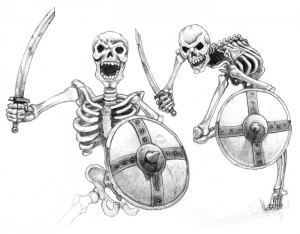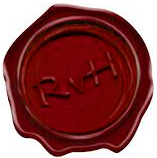In this foray into undeath, I will explore the subject of several common types of undead: skeletons, zombies, and ghouls. Before you say, “Oh my!” rest assured they are not nearly as frightening as they may seem.
First, some common traits of undead. Undead in general are unaffected by psionic and spirit effects with some exceptions. the most notable being their reaction to spells that Cure and Inflict wounds. Unlike living creatures, undead are harmed by Cure spells and healed by Inflict. Necromancers who command undead use this to their advantage, particularly with area Inflict spells that simultaneously harm living creatures and and heal undead. It is important to remember that this can be used against them with Cure spells, however.
Undead creatures also react differently to sunlight. Most undead cannot exist in direct natural sunlight. Shining magical sunlight upon undead may be effective, to a varying degree. Sometimes it can destroy, injure, blind, or cause a pain-like reaction. Other times it simply irritates them. If you see undead out-of-doors in the daytime, you should expect the undead to be formidable indeed.
There are also some spells specifically designed to deal with undead. As this is a guide for the common man, I will not delve deeply into spirit hunter skills, but the ability to Turn Undead is common enough to warrant some discussion. Turn Undead works as a Mass Fear or Whirlwind that only targets undead. Situational, but still very powerful you say? Well, necromancers have an altered version, Bolster Undead, which can provides resistance to one or more Turn Undead attempts. Therefore, it is not recommended to attempt to Turn only once. If you are going to Turn, be prepared to do so 2-4 times, or find another way to deal with the undead.
With the preliminaries out of the way, our first undead subject is the skeleton. Skeletons are easily  identified by a lack of flesh exposing bare bones. Skeletons are often dressed in rags, but can be well armed and armored. Not much more need be said of them, most skeletons can be dealt with in a few sword blows, though there are exceptions.
identified by a lack of flesh exposing bare bones. Skeletons are often dressed in rags, but can be well armed and armored. Not much more need be said of them, most skeletons can be dealt with in a few sword blows, though there are exceptions.
Zombies are a different matter. Zombies are rotting, slow-moving corpses. While slow, they can pack more of a punch than skeletons. Zombies often take 20 or even 50 regular sword blows before they stop moving. Even when they have been put down, they are still a potential danger. It is good practice to be wearing gloves before handling any corpse, but this is especially true of corpses that have been shambling around, bumping into each other, and being exposed to the bodily fluids of various victims for Incarnations know how long. For your own safety, don gloves before searching a defeated zombie.
Ghouls are more troublesome than skeletons and zombies. They possess pale white skin and flesh, and are marked by an insatiable hunger to consume people. Ghouls are often encountered with zombies and skeletons, but are distinguished by their ability to paralyze their foes and dragging them off to be devoured. Therefore, it is imperative to use a “buddy system” when ghouls are present to ensure that no one is left behind. A single ghoul can typically consume a full grown adult in 5 to 10 minutes, less if more than one ghoul consumes the same corpse.
For more information on undead, consult a spirit hunter. Current spirit hunters in Elmerton are Reinen and Eraku.
 Rybin vanHolt
Rybin vanHolt
Historian and Scholar

